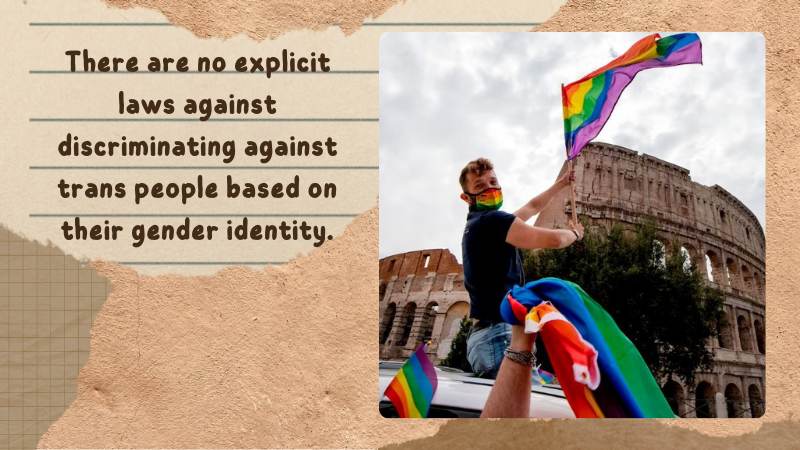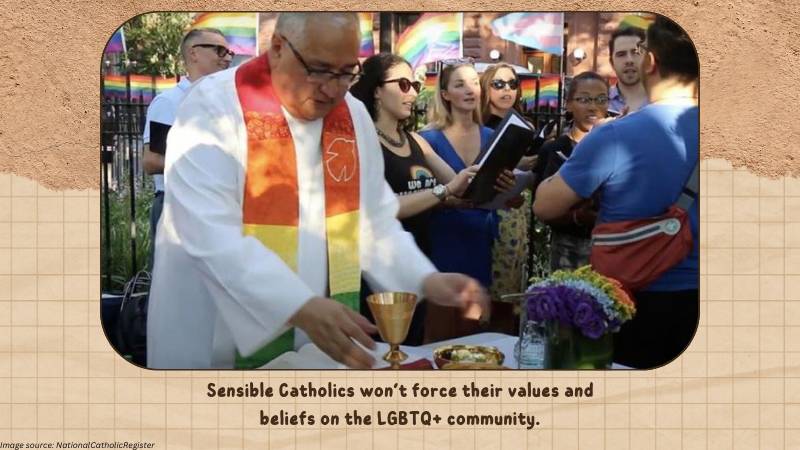How Accepting Are Italian People of the Transgender Community?

I’m an avid traveler. So, after the whole COVID-19 fiasco, I planned to do more trips.
One place got my attention though, Italy! Since I’m an MTF crossdresser, the recent talk of LGBTQ+ acceptance,
particularly trans rights, which made me pause.
Should I go on trips to Italy without worry?
Will I be safe?
If you’re as curious as me, this article is for you.
But this isn’t just for our trans darlings and members of the rainbow community.
It’s also for our LGBTQ+ ally friends who want to show support.
Not a fan of the LGBTQ+ community?
Not a problem. This article also answers a timely and important question:
Just how important it is for those who identify as queer to be accepted or at least, given basic human rights?
Italian Progressivity

Many people think Italy is a traditionally Catholic country.
Most assume Italians hold a rather conservative perspective when it comes to gender, identity, and sexuality.
Well, that is indeed the case — officially.
The Vatican, situated within Italy’s capital of Rome, is the headquarters of the Roman Catholic Church.
It still officially refuses to bend to LGBTQ+ rights, sure.
But Italian society as a whole has become increasingly progressive.
Despite this, LGBTQ+ folks, especially transgender individuals battle over winning mainstream acceptance.
The country has a law against discriminating based on gender identity.
But the legal system can’t shield trans people against transphobia 24/7.
I believe, in the grand scheme of things, it’s better that these challenges remain.
As long as social attitudes towards the community evolve. And evolve it did.
More and more Italians support transgenders receiving the same protections and rights as anyone else.
In fact, in a 2017 survey, 65% of Italians interviewed agreed that
“those who dress and live as one sex even though they were born another were brave.”
Italy and the Transgender Community

Italy has surely come a long, long way in accepting the transgender community.
I won’t deny that. But there’s still ample room for improvement.
When it comes to LGBTQ+ political and human rights protection, Italy placed 34th among 49 European countries.
Why did it place so low?
These difficulties are credited to unjust views planted by cultural and religious beliefs.
Legal Protections and Legal Rights

There are no explicit laws against discriminating against trans people based on their gender identity.
However, there are notable events, laws, and bills passed in the country that constantly reinforce its support for the group.
- In 1982, transgenders were allowed legal name changes. It was the 6th country to do so.
- In 2003, the law against discrimination based on sexual orientation was established.
- In 2008, the Italian Ministry of Infrastructure and Transport compensated a trans individual 100,000 euros. The Ministry discriminated against the person’s sex and asked the transgender to retake the driving exam.
- In 2021, the Chamber of Deputies made it illegal to display homophobic or transphobic messages on vehicles and streets.
- In January 2023, a court ruled in favor of a trans individual when a school fired the professor and claimed it falls under sex discrimination.
- In February 2023, a Trento court ruled trans minors can legally alter their gender, along with the corresponding documents.
This is so long as their parents and psychologist were consulted and consented.
Gender-Affirming Healthcare

In Italy, access to healthcare, particularly transition-related ones, is limited and complex.
Technically, hormone therapy and surgeries needed to align with trans people’s chosen gender are available.
But they’ll have to bear long waiting times and sift through insufficient care providers.
Law n. 164 of 1982 is considered the first law linked to gender change and recognition.
However the law requires two steps to be labeled a transsexual.
- Requiring authorization to do the gender reassignment surgery
- A mandatory operation, followed by obtaining the authorization to alter gender and name on personal documents
A 2015 interpretation of the law removed the mandatory operation. (A definite win for the MTF and FTM transitioners!)
Social Attitudes

In the past, as you can imagine, being openly transgender in Italy was akin to an open invitation.
Invitation to what? Bias, discrimination, and even violence.
Fortunately, in recent years, the youth has pushed for modern laws and tolerant social attitudes.
Thanks to the speedy availability of information, courtesy of the internet, it’s now easier to share relatable stories.
The web makes trans horror stories tangible and courts the population’s empathy.
With the younger folks at the helm, even the older generations are urged to
broaden their minds on LGBTQ+ rights and freedom of gender expression.
But Rome is the Capital of Italy

Rome is where the Romans roamed before (see what I did there?).
Like the Greeks, they had no issue with men fondling men, but cultural eras changed.
Today, Rome holds Venice. This doesn’t mean there are no LGBTQ+ participants in the place.
It means they just have to be low-key.
With such close proximity to a “holy” location, it’s no wonder the Catholic church still holds a significant sway in the place.
Meaning, the church’s conservative teachings can translate to intolerance of LGBTQ+ people.
At the same time, Catholic values include loving one’s neighbor.
Sensible Catholics won’t force their values and beliefs on the LGBTQ+ community.
At the same time, those in the community don’t flaunt their relationships and continue the two groups’ mutual regard for each other.
Cultural Influences

Italy is mostly an accepting country, with some places more welcoming than others.
So, if you’re planning to visit Italy, go to Florence, Milan, or Venice.
Even Rome is a good spot to mingle.
The best hotspots that are also very welcoming to LGBTQ+ folks are Sicily, Taormina, and Capri.
You can’t expect the same in more rural areas.
Remember though, that the key here is conducting yourself in a respectful manner.
The Catholic Church

Pope Francis, the current pope, is widely considered a complicated person for those of us in the LGBTQ+ community.
The Catholic Church has a long history of rebuffing those in the community.
Yet, Pope Francis adopted a more conciliatory tone when LGBTQ+ groups.
Moreover, under him, the Vatican released various statements and documents.
All were controversial, to say the least, as they launched both boos and applause.
For instance, the Pope voiced his support for civil unions in 2020.
In 2023, the Vatican followed it with a formal document blessing same-sex unions.
Another document indicated including trans individuals in Catholic events like baptisms and weddings.
All in all, the Italian legal and cultural systems still have a ways to go to ensure complete inclusion.
But if we focus on the subject’s most recent developments,
no one can deny that there had already been a high leap between Italy then and now.
Improving Transgender Visibility

March 31 marks the annual International Transgender Day of Visibility.
But it doesn’t mean we should only look for this visibility on that one day alone.
In Italy, this visibility is still a work in progress. Sure, protections exist.
But there is so much more to be done to encourage trans inclusiveness and acceptance.
But how can we do this? I have a few suggestions:
Education

Understanding is the foundation of genuine acceptance.
Educating the Italian population about the transgender and the LGBTQ+ experience as a whole is key.
Schools should consider incorporating appropriate lessons on gender identity and expression.
After all, students should have proper discernment and interpretation.
The goal here is to stimulate cognizance from an early age.
It’s also a preventive measure against bigoted opinions and harmful actions such as bullying.
Universities can also make gender studies courses more widely available. But not as a requirement.
This is to curb any negative feelings of being forced to learn about the LGBTQ+ groups.
Media representation

The media remains to be a potent messenger and influencer, especially in the younger crowd.
This is why queer media need to establish LGBTQ+ characters inspired by lived experiences.
It’s true that positive representation impacts cultural attitudes and paints the community in a good light.
But only presenting positive media robs the group of deeper exploration and connection to viewers.
I stand by my argument that it’s best to treat LGBTQ+ characters as just normal characters.
Because they are! I crave for complex queer characters with depth.
Give me a bisexual character brought up in the most loving household.
One with no problems in the world but still fell in with the bad crowd.
Give me a gay villain with the perfect witchy laugh and sinister plots to defeat the hero.
Give me a transman with a pregnant belly!
Offer queer characters with breadth. Or make them shallow — it’s okay!
Don’t push all queer characters into one, expected mold.
Queer characters shouldn’t be mere quotas or representation hires.
Legal system

Problems with the legal system are not just an Italy-specific conundrum.
All around the globe, in whichever country you may be, there are law gaps concerning queer groups.
Like in Italy, most places have protections against discrimination based on gender identity and expression.
But do you know what will make a world of difference?
Simplifying legal processes and explicitly creating non-discrimination laws.
That’s it. For instance, simplification of acquiring trans individuals’ official documents with altered names and gender.
Healthcare

In Italy, where transgender healthcare is lacking, improving the healthcare system is crucial.
Training professionals such as psychologists, doctors, and nurses on trans-specific procedures and surgeries is necessary.
Trans care should also cover insurance, mental health resources, and trusted authorities to report incidents of mistreatment.
Workplace

Ah, the workplace. A place none of us can escape without being trust fund babies.
In my experience, most of the places I worked at, especially those with an office setting, are like high schools for adults.
There are ass-kissers, profs with sticks up their butt, and gossipers. Oh, there’s also the cafeteria food.
Do you want to go back to this type of high school? I don’t.
This makes it scarier for LGBTQ+ members if they don’t have a definite wall to lean on.
So, companies should promote inclusion.
Not creating rules against bias and discrimination but also implementing those when unsolicited behaviors arise.
Properly training staff on how to support their workmates, whatever gender they may identify with, is also important.
A workplace with an open culture breeds comfortability and leads to a more dynamic and productive team.
Be sure that no group or employee is discriminated against in hiring, pay, benefits, promotions, etc.
Conclusion
Italy is making progress when it comes to transgender and LGBTQ+ rights and acceptance.
This is a great feat, despite the reality that there’s still a pretty glaring space it has to fill to be called a truly inclusive country.
The good thing here is that the younger generation holds the light of hope in this time.
While older folks stubbornly venerate their traditional views, these younger people are more open-minded and emphatic.
There is also the issue of insufficient legal protections that keep social stigma alive.
At the end of the day, the answer to how accepting Italian people are depends on the where and who of a trans person’s experience.
In general, everything seems to be going on a positive note.
I believe that with more education and exposure, Italians will continue down the path of greater inclusion.
For now, transgender individuals can find both struggles and support in Italian society.
Open your heart and continue the inclusive trend by supporting and advocating for LGBTQ+ rights!
- Microdosing Femininity: Simple Ways to Embrace Your Feminine Energy
- Crossdresser’s Guide: How to Stuff Your Bra and Make It Look Real
- How to Take Sexy Pictures: Tips and Tricks for Crossdressers
- What’s in Your Purse? The Ultimate Crossdresser’s Survival Kit
- A Beginner’s Guide to Safe and Comfortable Tucking for Crossdressers
- The Ultimate Guide to Storing Your Crossdressing Supplies Discreetly
- How Accepting Are Italian People of the Transgender Community?
- How to Embrace Authenticity as a Black Femboy Crossdresser.
- MTf Transgender Guide to Overcoming Transphobia and Transmisia
- How to Become a Feminine Man: Fashion & Personality
- Why Crossdressing Is Often Misunderstood: From A Crossdresser View
- Companions in Expression: The Role of Pets for Crossdressers
Established in 2009, We are a recognized manufacturer and seller of professional crossdressing products.
It is our aim to become not just the most creative manufacturer but also a very considerate seller, as we provide the best quality products for crossdressers all around the world.

















 Breast Forms
Breast Forms  Body Suit
Body Suit  Realistic Mask
Realistic Mask  Femini Girdle
Femini Girdle Hip & Butt Enhancement (8)
Hip & Butt Enhancement (8) Penis Prosthesis
Penis Prosthesis Fake Muscle
Fake Muscle Bikini
Bikini  Wig
Wig  Corsets
Corsets Course
Course service@roanyer.com
service@roanyer.com +8618652200711
+8618652200711 Facebook
Facebook YouTube
YouTube Twitter
Twitter Instagram
Instagram




